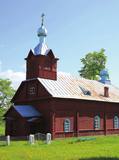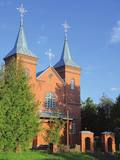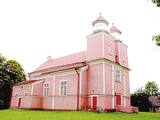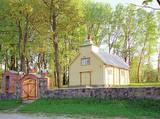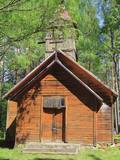| Nr | Name | Beschreibung |
|---|---|---|
|
Tiskādi Old-Believers Prayer House was built in 1886 and reconstructed
in 1905. The large church was sanctified 100 years ago. It is situated in the district which is mostly populated by Old Believers. The church stands on the hill.
|
||
|
Nelielā izmēra ēka (balts ķieģeļu mūris, ar dēļiem apšūts zems tornis) atrodas Liepājas – Klaipēdas šosejas (A 11) malā. 20. gadsimta sākumā tā kalpojusi kā lūgšanu nams, taču tā paša gadsimta vidū pārbūvēta, uzceļot torni. |
||
|
0,2 km austrumos no Vidsmuižas atrodas no šķeltajiem laukakmeņiem un sarkanajiem ķieģeļiem celtā (1910. - 1912. g.) Vidsmuižas katoļu baznīca. Tāpat kā Riebiņos esošā, arī šī ir uzskatāma par tipisku 19. – 20. gs. mijas Latgales lauku baznīcas paraugu. |
||
|
Holy Trinity Roman Catholic Church of Stoļerova. The construction
works of the church were finished in 1999 by the support of dean Butāns. The building is slightly larger than
the previous one; the newest (restored) church in Rēzekne district. The church has a specific icon of Our
Lady that was transferred from the chapel of Rozenmuiža.
|
||
|
Befindet sich im Südteil der Siedlung Feimaņi. Die Kirche wurde von 1756 bis 1760 gebaut. Feimaņi war ein Eigentum der Baronengeschlecht von Korff. Die Kirche gehörte verschiedenen Konfessionen gemäß dem Religionswechsel der Baronen von Korff vom Luthertum zum Katholizismus. Es lohnt sich zu erwähnen, dass die katholische Kirche in Feimaņi sich zwischen den Kirchen im Bezirk Rēzekne durch größte Anzahl der Kunstdenkmäler von staatlicher Bedeutung auszeichnet. Darunter sind eine Beichtbank, Kirchenbänke, einen Orgelprospekt, Silberbecher und fünfzehn Holzschnitzereien des Altars, darunter drei aus dem 18. Jahrhundert zu erwähnen. Bei den Kirchentoren erhebt sich einen Glockenturm mit vier Glocken. Während der Karwoche werden in der Kirche anstatt der Glocken die s.g. “Klappern” verwendet. Die sind 2 m lange un1 m hohe Gegenstände, die an altertümliche Wäschemängel erinnern. In Feimaņi befindet sich eine der drei Fahnenherstellungswerkstätten Lettlands, die mit den modernsten Einrichtungen im Baltikum ausgestattet ist. An diesem Ort wurde sowohl ideologisch als auch physikalisch die Fahne Lettgallens “geboren”. |
||
|
Auffällig sind die beiden 60m hohen Türme des im Barockstil erbauten Gotteshaus. Die Kanzel, der Orgelprospekt, die Orgel und ein Beichtstuhl stammen aus dem 18. Jh., die Seitenaltäre vom Beginn des 19. Jh. Im zentralen Teil des Altars befindet sich das Gemälde „Die wundertätige Gottesmutter von Aglona aus dem 17.Jh., dem Heilkräfte zugesagt werden, daher wird es nur zu bedeutenden Zeiten gezeigt. Vor dem Besuch des römischen Papstes Johannes Paul II in Lettland im Jahre 1993 fanden umfangreiche Renovierungs- und Umbauarbeiten am Kirchenkomplex statt. Alljährlich kommen am 15. August Pilger nach Aglona, um das Fest Mariä Himmelfahrt zu feiern. Etwa 100m von der Basilika befindet sich die heilige Quelle Aglonas Svētavots. |
||
|
Eine einzigartige Kirche mit einem im 17. Jh. beiseite gebauten Glockenturm. |
||
|
Atrodas pie Līvānu dzelzceļa stacijas, Dzelzceļa ielā 17. Tā kā Līvānos nebija luterāņu baznīcas, draudze dievkalpojumus noturēja ugunsdzēsēju depo. 1929. gadā ielika dievnama pamatakmeni un pēc trīs gadiem pabeidza pašas ēkas celtniecību. Saglabājušās ziņas, ka padomju laikā baznīcā bija plānots iekārtot sporta zāli un noliktavu, taču tas neticis īstenots. Jāpiemin, ka baznīca ir celta uz bijušās korķu fabrikas pamatiem. Dievnama zvana iegādei līdzekļus sarūpēja kara ministrs – ģenerālis Jānis Balodis u.c. |
||
|
St. Michael the Archangel Parish Church of Zosna. The church
was built in 1800 by the donations of local people; it is devoted to Saint Michael. The church is built on the
stone foundation and panelled with boards. It has a small square tower that was restored in 1994.
|
||
|
Das beindruckende Denkmal des lettgalischen Barocks. Gebaut in der Periode von 1755 bis 1767 nach dem Projekt des italienischen Architekten A. Parako. Eine Kapelle mit der Reliquie vom St. Donatus, dem Beschützer von Krāslava. |
||
|
Krustceļi Old-Believers Prayer House was built in 1939.
|
||
|
1.2 km to the south of the centre of Ģipka and on the side of the Jūrmala-Kolka road (P131), this church makes it hard to believe that the rock church was built very recently – after 1992, because it was burned down during the Soviet occupation in 1979. Ironically, the Dundaga forestry fire safety post was housed in the steeple of the church after World War II. The ornate altar and organ were destroyed in the fire, but the altar painting, “Christ on the Cross,” was saved. The church is now once again open for business. |
||
|
Die kleinste und eine der reichtesten Kirchen Nordeuropas im Sinne der Zierelemente. Seit dem Bau im 14. Jh ist äußerlich kaum verändert worden. |
||
|
Das Gotteshaus hat eine nicht traditionelle Planung und Einrichtung: Der Altar befindet sich in der Mitte, aber die Kanzel – über dem Altar. Die Kirche hat einen eigenartigen Glockenturm mit einer im Jahr 1634 gegossenen Glocke. Die heutige Innenausstattung aus Holz haben die Schüler der Handwerkerschule von Riga geschaffen. Neben der Kirche befinden sich die Ruinen der alten Kirche und das Pfarrhaus, wo am Ende des 18. Jhs. als Hauslehrer Garlieb Merkel gearbeitet hat, der das in Liepupe Beobachtete in seinem bedeutenden Werk Letten verwendet hat. |
||
|
The Lode (Apši) Lutheran Church is between Lake Bānūži and Lake Ilze. It is a unique example of wooden architecture and dates back to 1780. The log church had a straw roof until the early 20th century, at which point a shingled roof was installed instead. |
||
|
was built between 1930 and 1947. On both sides of the altar are sculptures of angels that date back to the late 17th century and were sculpted in Subate. They are the only elements of this kind in the Baroque decorative sculpture in churches in Kurzeme. It may be that the figure of the Saviour on the cross with a sleeping lamb at his feet was produced by the same artists. No one knows how the artworks arrived in Subate. The organ with its wooden pipes was manufactured by Juris Bokums. During the season, the interior of the church can be toured, and if you contact the church in advance, you can arrange for organ music performances. |
||
|
Atrodas Grobiņas centrā, Dzērves laukuma malā. Pirmā baznīca Grobiņa bija celta jau ap 1560. g., bet nākamā – 1596. g. celtā iznīcināta 1659. g. zviedru iebrukuma laikā. Pēc Kurzemes un Zemgales hercoga Jēkaba Ketlera iniciatīvas 1664. g. tiek uzcelts jauns dievnams, ko atjauno 1892. gadā. Tas dedzis 2. pasaules kara laikā, bet vēlāk atkal atjaunots. Šobrīd notiek altāra restaurācijas darbi. |
||
|
The Apriķi Lutheran Church is, for good reason, known as one of the most beautiful churches in Kurzeme. It was owned by the Osten-Zacken dynasty in the past, built in the 17th century, and rebuilt in 1710. The wooden interior is in the Rococo style with elements of the Baroque, and it dates to the mid-18th century. It is amazingly ornate. The beautiful ceiling paintings, which were produced by a Prussian painter called Rode, were painted between 1744 and 1746. |
||
|
Krupenišku Old-Believer Prayer House was built in 1908. The autor of the
design is engineer I. Ivanov. At present the church is in bad tehnical condition.
|
||
|
Atrodas iepretim bākai. Saukta arī par Pizes (Miķeļtorņa lībiskais nosaukums) baznīcu. To uzcēla 1893. g. Padomju laikā ēkā bija izvietots pionieru nometnes klubs. Tagad tā atkal kalpo savam pamatmērķim. |
||
